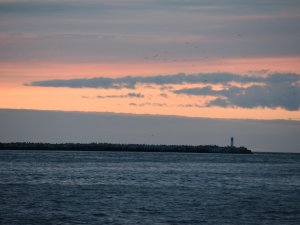
Permits issued for the fatal deterrent of grey seals from fishing gear
To address years of fishermen's frustration over the disturbance of coastal fisheries by grey seals Halichoerus grypus,the Nature Conservation Agency(the Agency) is this year for the first time issuing permits to 19 legal entities to lethally deter grey seals. The permits are issued under a number of safety and species protection conditions. Only certain legal entities with permits will be allowed to conduct grey seal lethal hauls from 1 September to 31 December, using hunting weapons and taking a maximum of 60 grey seals in total.
"The purpose of issuing the permits is not to reduce the number of seals in the Baltic Sea and Latvian coastal waters, but to provide fishermen with another alternative method to reduce the damage caused by seals to coastal fisheries and reduce conflict situations," said Gita Strode, Director of the Nature Conservation Department of the Administration.
The Baltic Sea is home to around 60 000 grey seals, which, according to fishermen, regularly consume fishermen's catch in traps, nets and tear fishing gear. "The 'conflict' between fishermen and seals is very high. It is hoped that deterring grey seals from fishing gears by using hunting weapons will be a solution to keep seals away from fishermen's catches, so that fishermen can continue with their traditional trade," hopes the Ministry of Agriculture.
The grey seal is a protected, non-hunted species. To address the conflict, several projects have been implemented in Latvia to adapt methods used in other countries to deter seals from fishing gear. At the same time, in recent years, fishermen have officially reported seal damage. Based on the data received, the Rural Support Service has already paid more than €557 000 in compensation to fishermen for damage caused by grey seals between 2020 and 2022.
"As the population of grey seals in the Baltic Sea continues to grow, so do the conflicts between fishermen and seals. Fishermen who have received permits will have to report and provide data on the progress of this deterrence, so that after this year's fishermen's reports at the beginning of 2025, we can carefully evaluate the effectiveness and efficiency of the lethal deterrence method in Latvia in cooperation with scientists," explains G. Strode.
In 2021, the Ministry of Environmental Protection and Regional Development approved a Species Conservation Plan for the species group "Seals". The plan identifies the best solution for deterring seals as a combination of different methods, including the possible harvesting of grey seals in close proximity to fishing gear, with a maximum total number of animals to be harvested per year of no more than 1% of the estimated population of grey seals in Latvian waters, similar to other neighbouring countries.
The harvesting of 1% of the existing Latvian population, or 60 individuals, does not in any way threaten the population of grey seals in the Baltic Sea. Moreover, the aim of lethal deterrence is to try to change the seals' behaviour, to make them understand that foraging near fishing gear is dangerous and to pass this information on to the young seals. It has been shown that there are some individuals in the population that have learned to eat fish out of fishing gear rather than catch them. In theory, if these few individuals can be caught, the tradition of eating the gear is broken, it is not passed on to future generations and the seals learn to catch their own food again in a natural environment."
The lethal deterrence of grey seal individuals is restricted to 19 specific fishing companies that fish commercially in coastal waters in accordance with fisheries legislation to prevent serious damage to fisheries. During the deterrent period, the requirements of the hunting legislation, including the ban on the use of lead ammunition, and the removal of the individual grey seal from the sea, must be complied with. The seal may not be used for commercial purposes and may be handed over for disposal or personal use. Permit holders must contact the Management Authority whenever a lethal seal release is to take place, both before and after the release. Violation of the conditions of the permit issued is punishable by a fine of up to EUR 10 000.
Only the use of lethal methods of deterrence requires a permit from the Management Authority. Visual and acoustic deterrent methods and tools, including those producing a sound similar to the use of hunting weapons, in so far as the use of such tools does not contravene the requirements of hunting regulations or other laws and regulations, may be used without prior approval and authorisation.
Before issuing a permit for the taking of individuals of non-hunted species, the Authority has checked the legality and scientific justification of the planned activity, and has consulted the Ministry of Agriculture, the Scientific Institute for Food Safety, Animal Health and the Environment "BIOR", the State Forest Service and coastal fishermen.
The Baltic Sea is home to three species of seals: the spotted seal, the knob seal and the grey seal. The grey seal, the largest of the three Baltic Sea species, can reach 150-300 kg as an adult and has large nostrils spaced apart in a W shape. The hooded seal Pusa hispida differs from the grey seal by having a shorter snout, smaller size and its nostrils are close together. The spotted seal Pusa vitulina has only been sighted a few times on the Latvian coast. Its nostrils are arranged in a V-shape.
Foto: Gunta Gabrāne